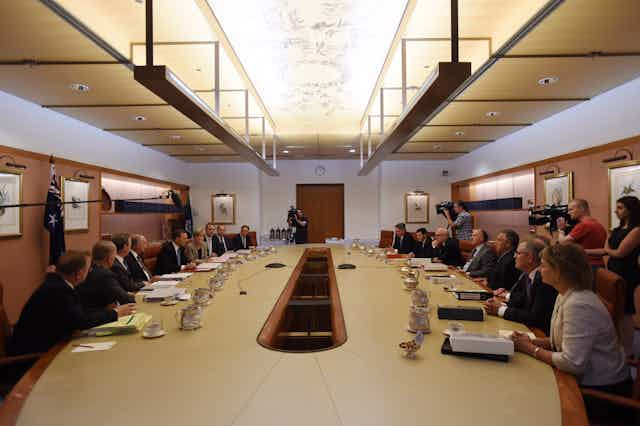Last weekend’s ALP national conference unanimously adopted a resolution to have women make up 50% of Labor parliamentarians by 2025. Women already make up 43.1% of Labor MPs in all Australian parliaments, as well as the majority of Queensland Premier Annastacia Palaszczuk’s cabinet. Labor’s decision to increase the quota was a fine tribute to the work of late Victorian premier Joan Kirner, the founder of EMILY’s List Australia.
Female Liberal politicians like current MP Sharman Stone and former senator Sue Boyce have used Labor’s moves as an opportunity to press their own party to adopt quotas. Education Minister Christopher Pyne has said, though, that quotas are contrary to the merit principle, while agreeing that something should be done to get more Liberal women into parliament. But what?
It is difficult to maintain with a straight face that party preselections are based on “merit” rather than voting numbers acquired in a variety of ways. As Stone has said previously:
You’ve got to be in the right place at the right time, laugh loudly at the leader’s jokes, and work hard for your faction.
The Liberal Party’s problem
Women currently make up only 22.6% of Liberal parliamentarians around Australia. Even with Sussan Ley’s appointment as health minister at the end of 2014, women make up only 11% of Tony Abbott’s cabinet. Ley joined Julie Bishop, who was previously federal cabinet’s sole woman.
In 2010, then-senator Judith Troeth released a policy paper:
Modernising the Parliamentary Liberal Party by Adopting the Organisational Wing’s Quota System for Preselections
The paper’s title said it all. Troeth argued that it was illogical for the Liberal Party to reject quotas for preselecting election candidates when it has always accepted them for the organisational wing of the party. This is most notable in Victoria, where half of the positions up to and including metropolitan and rural vice-presidents are reserved for women.
Troeth was particularly concerned to increase the number of women available in the “pool” from which executive leadership was drawn.
With the support of then-Liberal leader John Hewson, the party had undertaken initiatives, such as the creation of the Liberal Women’s Forum, in the early 1990s to increase the number of Liberal women candidates. As a result, there was a surge of Liberal women into parliament in 1996.
However, things went backwards under the Howard government, which was adamant it would not “patronise” women by any kind of affirmative action.
Meanwhile, the quota first adopted by the Labor Party in 1994 – that women would be preselected for 35% of winnable seats at all parliamentary elections by 2002 – began steadily increasing the gap between the parliamentary representation of women in the Labor and Liberal parties.
The evidence supports quotas
More than 100 countries have some form of candidate quota. They have decided that positive action is needed to overcome the institutionalised bias against women in politics.
The implementation of such quotas has been of varying levels of effectiveness. Their success is dependent on factors such as how they “fit” with the electoral system, rank-order rules (that is, the position women are placed on candidate lists) and effective sanctions.
Nonetheless, thanks to quotas, the proportion of women in parliaments across the world has nearly doubled in the past 20 years.
Ireland has joined other European countries in legislating quotas, the first country with a Hare-Clark system to do so. All political parties supported its 2012 legislation, which requires them to field at least 30% women candidates at the next election and 40% at the election after that.
The penalty for parties that fail to comply will be a loss of half of their annual public funding.
Despite its international commitments to achieving gender balance in public decision-making, Australia has not taken similar positive action. Since 1999 it has slipped from 15th place on the Inter-Parliamentary Union’s ranking of national parliaments for the representation of women to 42nd place.
The slip was even greater when there was a series of Coalition victories at state level. The representation of women in Australian parliaments declined not only relative to other democracies but also in absolute terms, as seen below:
What else could help?
It is not just absence of quotas that is the problem for women in Australian politics. They have been made to feel unwelcome in other ways. When Australia’s new parliament house was opened in Canberra in 1988 it had a pool, a gym, a snooker room and a meditation room but no childcare centre, despite vigorous campaigning by female senators.
The campaign lasted for another 20 years before a small childcare centre was finally opened in 2009 – for a workplace in which there are 3500 people in sitting weeks.
A Senate standing order treats a baby or toddler brought into the chamber as a “stranger”. Democrats senator Natasha Stott-Despoja helped lead an amendment to the standing orders in 2003 to allow a senator to breastfeed an infant. But, in 2009, then-Senate president John Hogg ordered the removal of Greens senator Sarah Hanson-Young’s two-year-old daughter.
Those campaigning for gender equity in Australian politics need a great deal of stamina. Those pushing for quotas in the Liberal Party may have this stamina, but they are from the wrong faction and are up against entrenched resistance. It’s unlikely that the partisan gender gap will be closed any time soon.

